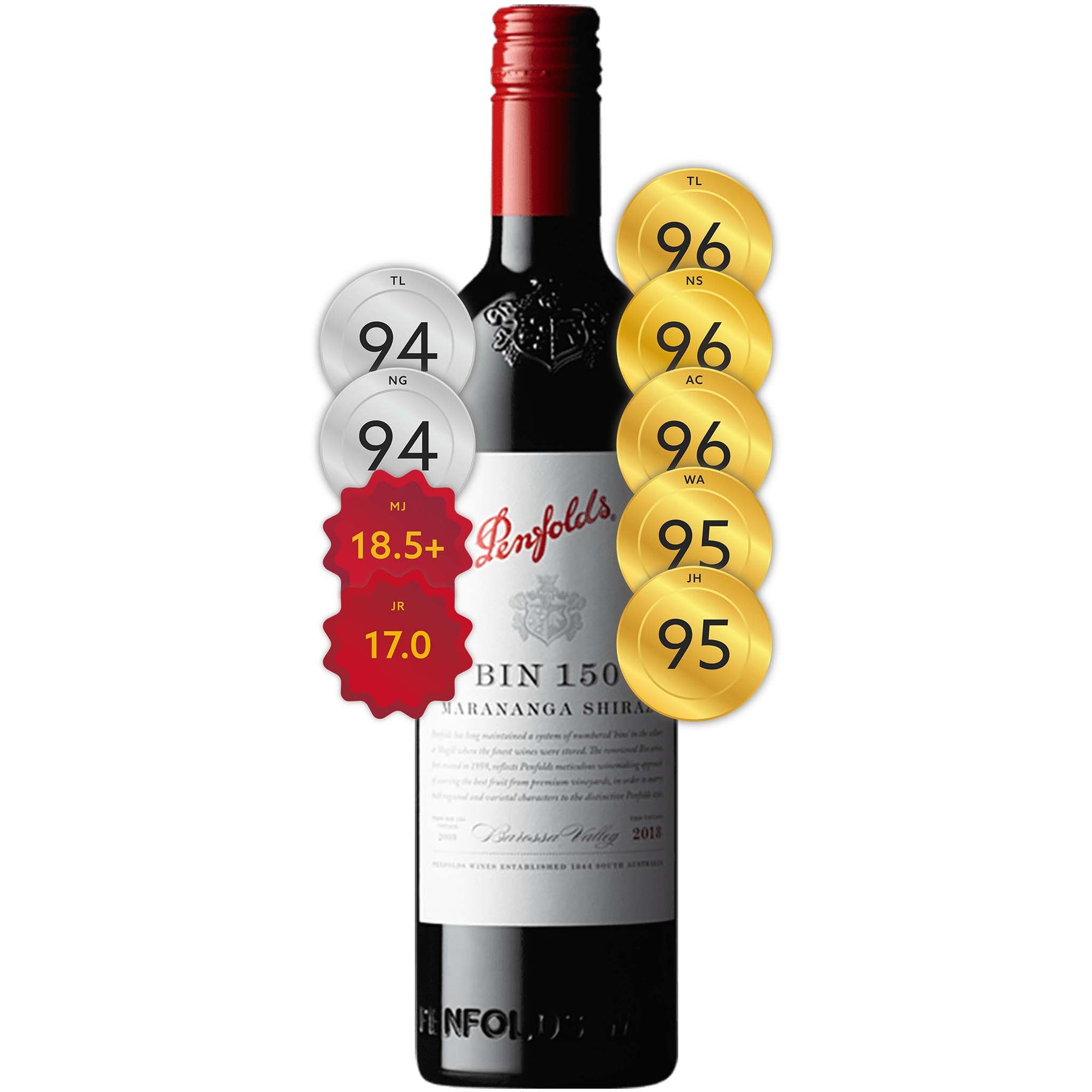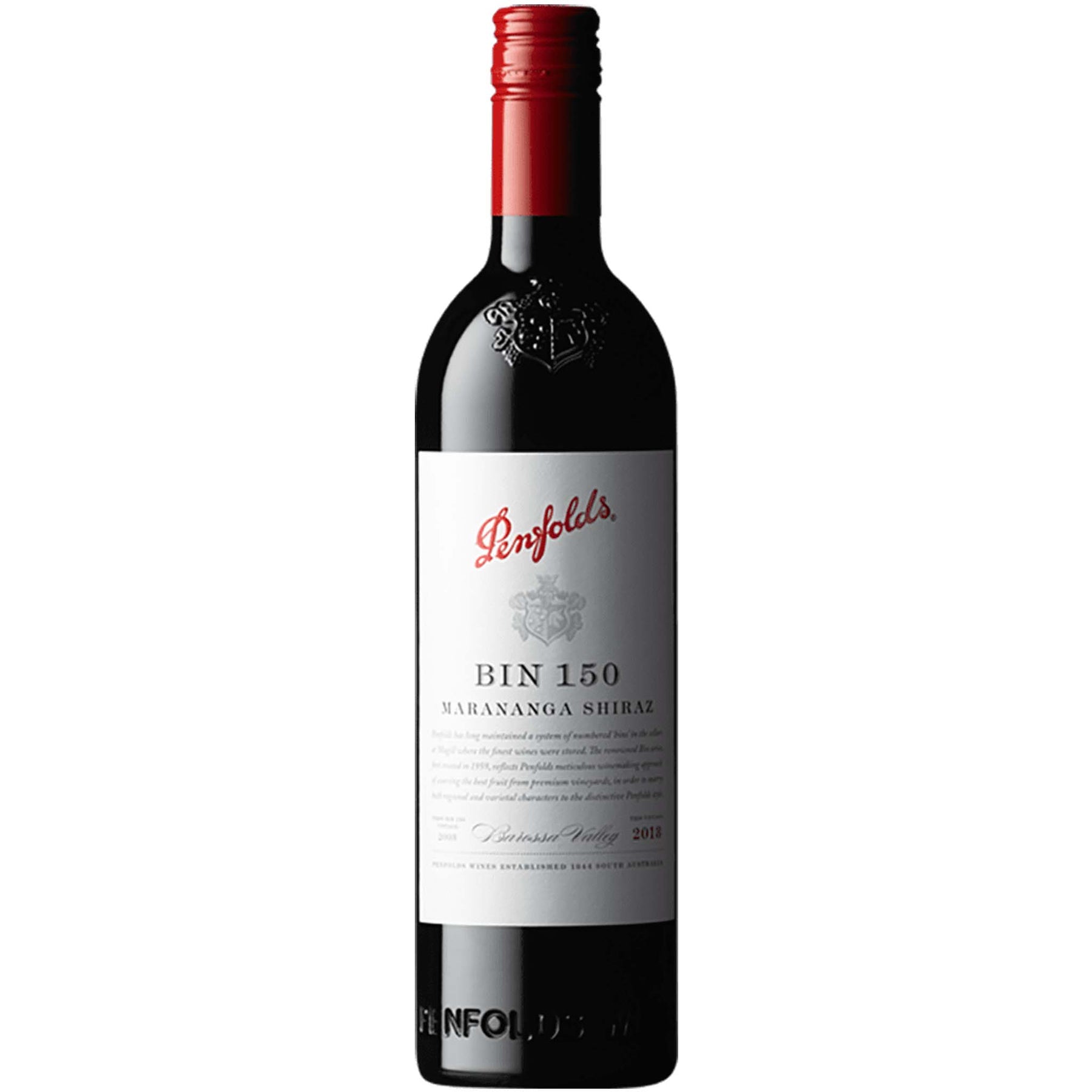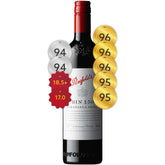

Penfolds Bin 150 Marananga Shiraz 2018
Style: Red Wine
Variety: Shiraz
Closure: Screwcap
Penfolds Bin 150 Marananga Shiraz 2018
Warehouse
34 Redland Drive
Vermont VIC 3133
Australia
Critic Score: 96 and 18.5/20
Alcohol: 14.5%
Size: 750 ml
Drink by: 2038
Bin 150 is a relative newcomer to the Penfolds stable, first produced in the 2008 vintage. The wine is sourced entirely from the highly regarded Marananga sub-region of the Barossa, where the ancient soils of Marananga provide the backbone to some of the region's best-known wines. The wine typically displays the sub-regional characteristics of saturated colours, dark fruit profile and ripe tannins, which are enhanced by the Penfolds method of vinification and the use of hogsheads and puncheons.
"A bold, tarry and rich expression with a deeply embedded, dark-plum and blackberry core of aromas that are framed in very nicely fitted oak. The palate is breathtakingly deep and supple with such impressive, soft, plush ripe blackberries. Long, powerful and immaculately captured tannins. Bold and beautiful. Will age for two decades easily." Nick Stock
The 2018 Bin 150 was matured for 12 months in American (25% new, 25% 1 year old) and French oak (25% new, 25% 1 year old) hogsheads and puncheons.
"A defining Barossa shiraz, instantly recognisable for its sub-regional character and authoritative Penfolds stamp." Nick Ryan, Penfolds Rewards of Patience tasting panel member.
"Deep, dark red. On the nose, an instant formic lift, elevating a mix of African/Middle Eastern spices – cumin and dried fennel flirting with aromas akin to soaked dill-pickle juice. Less Marananga blueberry and juniper notes detected than normal, yet so many other shiraz variants leap forward to entice. The palate is a boysenberry/mulberry slurry, almost a coulis, with a smidgeon of cola/creamy soda flavours. Prominent tannins augment and propel an impression of a svelte film of raspberry seeds/pips, to heighten textural appeal. Supportive oak adds weight – contributing structurally yet hesitating to add to the flavour-pool. An ironstone/ferrous (haemoglobin) impression noted on back-palate. Peak drinking 2023 to 2035.
Vintage Conditions: Dry conditions prevailed during vine dormancy and the start of the growing season, with Marananga experiencing autumn rainfall well below average, a trend that continued into the early part of winter. A quarter of the long-term average rainfall was achieved in June. The second half of winter was wetter, with vines entering the growing season with good soil moisture profiles. Temperatures were below average during winter, however it warmed substantially through spring boosting vine growth and rushing the vines through flowering. Summer was dry, with no recorded major rain events. This carried into January with a heat spike around veraison causing vines to stall, pushing the start of harvest out by a week or so. The warm weather carried into autumn, setting up an Indian summer with favourable conditions for ripening grapes, and this coupled with dry conditions set up a high-quality vintage." Penfolds
Expert reviews
"Comes from a specific sub-region of the Barossa and from the time it was introduced into the range a few years ago, it has been one of my favourites. The regional stamp of ironstone minerally fruit is evident on the nose. Then the palate with its combo of French and American oak delivers a further statement of individuality, though still with that Penfolds watermark evident. Crushed ants on the nose with spicy dark plum and licorice with a palate of energy and generous fruit concentration. Love it." Tony Love, The West Australian - 96 points
"Deep crimson. Fresh elderberry dark cherry, blackberry, mulberry praline aromas with herb garden notes. Inky deep wine with deep set dark cherry, blackberry paneforte flavours, plentiful fine chocolaty tannins, roasted chestnut notes and integrated fresh linear acidity. Finishes chocolaty firm with persistent dark berry/ aniseed/ chinotto notes. Elemental but rich, dense and powerful. A Barossa Classic – showing the grandeur and class of the Marananga sub-region. Worth keeping for a while to allow the components to integrate. 12 months in 25% new French oak, 25% new American and one-year-old oak (25%/25%) hogsheads and puncheons. Drink: 2024 – 2035." Andrew Caillard MW - 96 points
"A bold, tarry and rich expression with a deeply embedded, dark-plum and blackberry core of aromas that are framed in very nicely fitted oak. There’s a 50/50 split of American and French and both are equally split between 50% new and 50% one-year-old. There’s a move to puncheons here, too. The palate is breathtakingly deep and supple with such impressive, soft, plush ripe blackberries. Long, powerful and immaculately captured tannins. Bold and beautiful. Will age for two decades easily." Nick Stock, JamesSuckling.com – 96 points
"Marananga sits at the centre (not quite geographically, but almost) of the Penfolds machine and Grange is certainly first in the queue when it comes to picking the most robust and noble fruit from this hamlet. But after Grange’s cavalcade has mooched back to the winery the Knights of Marananga gather the fruit for this superb thoroughbred. This is not a wine with the power or the bravado of 2010 or 2016 but it is a wine with sensational fluidity and velvetiness which is offset by minty freshness. This is a genial, elegant wine with terrific balance and singularity and there is enough fondant fruit in its core to, reasonably, drink now if you are desperate! But please hold, because while this is a Marananga anomaly, with less grunt and swagger than normal, it still needs time to open up and reveal its entire panoply of dark fruit tones. Bin 150 oscillates, encouragingly, year after year and because it is a non-blended wine, and so this honest reflection of its unique terroir makes it an outlier in this portfolio. In 2018, however, it is the beating heart of the collection." Matthew Jukes - 18.5+/20 points
"The raspberry and vanilla-scented 2018 Bin 150 Marananga Shiraz is a beauty. Aged in French and American hogsheads, it artfully marries fruit and oak, then blends in nuances of licorice, dusty earth and hints of black olives and roasted meat. Full-bodied and creamy textured, it's ripe while remaining fresh and lively, coming to a long, silky close. At half the price of RWT, it's a relative bargain. Drink: 2020-2035." Joe Czerwinski, Wine Advocate - 95 points
"A relatively recent addition to the Penfolds red wine line up, the impact of the first release ('08) still fresh in my mind. A relentless fusion of ripe berry fruits, earth and licorice, packed with ripe tannins and new oak (25% each French and American). From the heart of the valley floor, and proud of it. Drink by 2038." James Halliday, Halliday Wine Companion - 95 points
"Although recognisable as a true sub-regional signature of the Barossa, this wine doesn’t show the brute power of many Marananga predecessors. A very rich perfume has spice skipping over the edge of generous dark fruits – a comforting fruitcake cuddle that gets tighter as it lingers in the glass. Then cinders and soot start to bite in the deceptively firm back-palate. It suggests a long life, with many twists and turns ahead in the cellar." David Sly, Decanter - 94 points
"The Bin 150 Marananga 2018 Shiraz ($100) is a very likeable wine and slightly off-piste yet very interesting compared to many of the other Penfolds expressions of Shiraz. There’s a note of cola, brandied apricots even, and ginger nut biscuit in a wine that’s fleshy as you first taste then builds in tannin thickness yet is still quite navigable. It’s got a genuine individuality about it." Tony Love, Wine Pilot - 94 points
"A more recent addition to the Penfolds armoury, this was matured in both American and French wood, showcasing Barossa’s more floral and flamboyant side. Still, unashamedly full-bodied. Think lilac, blueberry, mulberry, cinnamon and star anise. Sumptuous. Exotic. The tannins, firm and an ample forebear to a bright future." Ned Goodwin MW - 94 points
"The inherently plush mood and deep purple allure of Manananga in a warm and dry vintage is scaffolded to compelling effect by Penfolds dexterity with both American and French oak and its signature tannin framework. The result is a deep and strong Marananga of medium-term promise that will wow lovers of Barossa density, gloss and polish." Tyson Stelzer - 93 points
"Penfolds Bin 150 is the ‘give ’em what they want and give ’em lots of it’ wine in the range. It’s plush, it’s creamy, it’s ballooned with sweet fruit, its tannin is soft to the point of melting. The vanilla notes here are clear, the plums are sweet and mushy, the aftertaste pulses with sweet, saturated fruit. It’s neat, it’s Penfolds, of course it is, but there’s a lot jammed in here. Drink: 2020 - 2030+." Campbell Mattinson, The Wine Front - 93 points
"Very deep blackish purple. Impressive freshness on the nose coupled with some sweetness. Just the job! Combination of ripe, sweet fruit, a hint of Barossa boot polish and yet apparently natural acidity nicely integrated with the smooth Shiraz fruit." Jancis Robinson MW – 17/20 points
After the success of early sherries and fortified wines, founders Dr Christopher and Mary Penfold planted the vine cuttings they had carried on their voyage over to Australia. In 1844 the fledging vineyard was officially established as the Penfolds wine company at Magill Estate.
As the company grew, so too did Dr Penfold's medical reputation, leaving much of the running of the winery to Mary Penfold. Early forays into Clarets and Rieslings proved increasingly popular, and on Christopher's death in 1870, Mary assumed total responsibility for the winery. Mary's reign at the helm of Penfolds saw years of determination and endeavour.
By the time Mary Penfold retired in 1884 (ceding management to her daughter, Georgina) Penfolds was producing 1/3 of all South Australia's wine. She'd set an agenda that continues today, experimenting with new methods in wine production. By Mary's death in 1896, the Penfolds legacy was well on its way to fruition. By 1907, Penfolds had become South Australia's largest winery.
In 1948, history was made again as Max Schubert became the company's first Chief Winemaker. A loyal company man and true innovator, Schubert would propel Penfolds onto the global stage with his experimentation of long-lasting wines - the creation of Penfolds Grange in the 1950s.
In 1959 (while Schubert was perfecting his Grange experiment in secret), the tradition of ‘bin wines' began. The first, a Shiraz wine with the grapes of the company's own Barossa Valley vineyards was simply named after the storage area of the cellars where it is aged. And so Kalimna Bin 28 becomes the first official Penfolds Bin number wine.
In 1960, the Penfolds board instructed Max Schubert to officially re-start production on Grange. His determination and the quality of the aged wine had won them over.
Soon, the medals began flowing and Grange quickly became one of the most revered wines around the world. In 1988 Schubert was named Decanter Magazine's Man of the Year, and on the 50th anniversary of its birth, Penfolds Grange was given a heritage listing in South Australia.
Despite great success, Penfolds never rests on its laurels. In 2012 Penfolds released its most innovative project to date - 12 handcrafted ampoules of the rare 2004 Kalimna Block Cabernet Sauvignon.
Two years later, Penfolds celebrated the 170th anniversary – having just picked up a perfect score of 100 for the 2008 Grange in two of the world's most influential wine magazines. Today, Penfolds continues to hold dear the philosophies and legends – '1844 to evermore!'.

South Australia
South Australian is responsible for more than half the production of all Australian wine. It is home to more than 900 wineries across 18 wine regions. The regions are Adelaide Hills, Adelaide Plains, Barossa Valley, Clare Valley, Coonawarra, Currency Creek, Eden Valley, Kangaroo Island, Langhorne Creek, McLaren Vale, Mount Benson, Mount Gambier, Padthaway, Riverland, Robe, Southern Fleurieu, Southern Flinders Ranges and Wrattonbully.
Many of the well-known names in the South Australian wine industry established their first vineyards in the late 1830s and early 1840s. The first vines in McLaren Vale were planted at Reynella in 1839 and Penfold's established Magill Estate on the outskirts of Adelaide in 1844.
South Australia has a vast diversity in geography and climate which allows the State to be able to produce a range of grape varieties - from cool climate Riesling in the Clare and Eden Vallies to the big, full bodied Shiraz wines of the Barossa Valley and McLaren Vale. Two of Australia's best-known wines, Penfolds Grange and Henschke Hill of Grace, are produced here. There is much to discover in South Australia for the wine lover.



